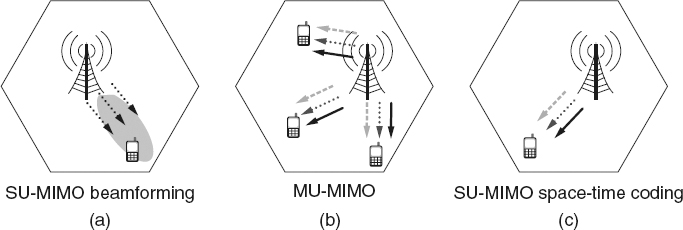Multiple Antenna Techniques
Another key technology for increasing the system capacity is the use of multiple transmit and multiple receive antennas, that is, using Multiple Input and Multiple Output (MIMO) techniques [6]. Over the past decade, MIMO techniques became a prominent capacity and reliability enhancement technology for many wireless communication standards including the LTE and WiMAX. Consequently, it is envisioned to remain and even to improve in IMT-Advanced networks.
MIMO techniques involve a variety of techniques aiming at different objectives in different scenarios. In general, they can be divided into Single User MIMO (SU-MIMO) and Multi User MIMO (MU-MIMO), see Figure 2.7. In SU-MIMO, the additional transmit and receive antennas are used to enhance the capacity as well as the reliability experienced by that user. These can be achieved by using space-time codes or beamforming. On the contrary, MU-MIMO generalizes these gains to multiple users. In particular, MU-MIMO exploits the multiuser diversity in allocating a group of users into the same time-frequency resource [7]. It facilitates achieving high transmission capacity while requiring simpler terminals. To elaborate, data streams on the UL can come from different MSs. The general setting assumes MSs transmitting normally to a BS utilizing more than one antenna. There is generally no coordination assumed between the MSs. Hence, the main challenge is how to schedule the MSs. As MSs are usually dispersed over the cell coverage area and are not predictable in their general behavior, it becomes hard to force a form of control on the non-coordinated behavior while utilizing the possible higher capacities possible.

Figure 2.7 Illustration of SU and MU MIMO systems.
Another classification of MIMO techniques in cellular systems is the single-site MIMO and cooperative MIMO. While the former encompasses different SU-MIMO techniques, like beamforming, spatial multiplexing, and transmit diversity, and MU-MIMO, the later encompasses the emerging Coordinated Multi-Point (CoMP) transmission and reception [5]. As the names suggest, single-site MIMO is concerned about enhancing the communication experience of in-cell users through employing any of the aforementioned techniques. On the contrary, CoMP aims at improving the communication experience of cell-edge users through inter-cell coordination. CoMP techniques will be described in subsequent sections.
A third classification of MIMO techniques is based on the utilization of CSI at the transmitter side. Under this classification, we have open loop techniques and closed loop techniques. In open loop techniques, the transmitter, the BS or the MS, does not need to have CSI information to adjust its transmission pattern. An example of this category is the single user space-time coding. On the contrary, closed loop systems benefit from the CSI at the transmitter to adjust its transmission parameters. This category encompasses MU-MIMO, SU-MIMO spatial multiplexing, SU-MIMO beamforming, and CoMP. Obviously, exploiting CSI allows the transmitter to achieve transmission rates as close to the capacity as possible at the cost of additional feedback overhead and receiver processing. This is in particular the case when the transmission frequencies of the UL are different from those of the DL.
